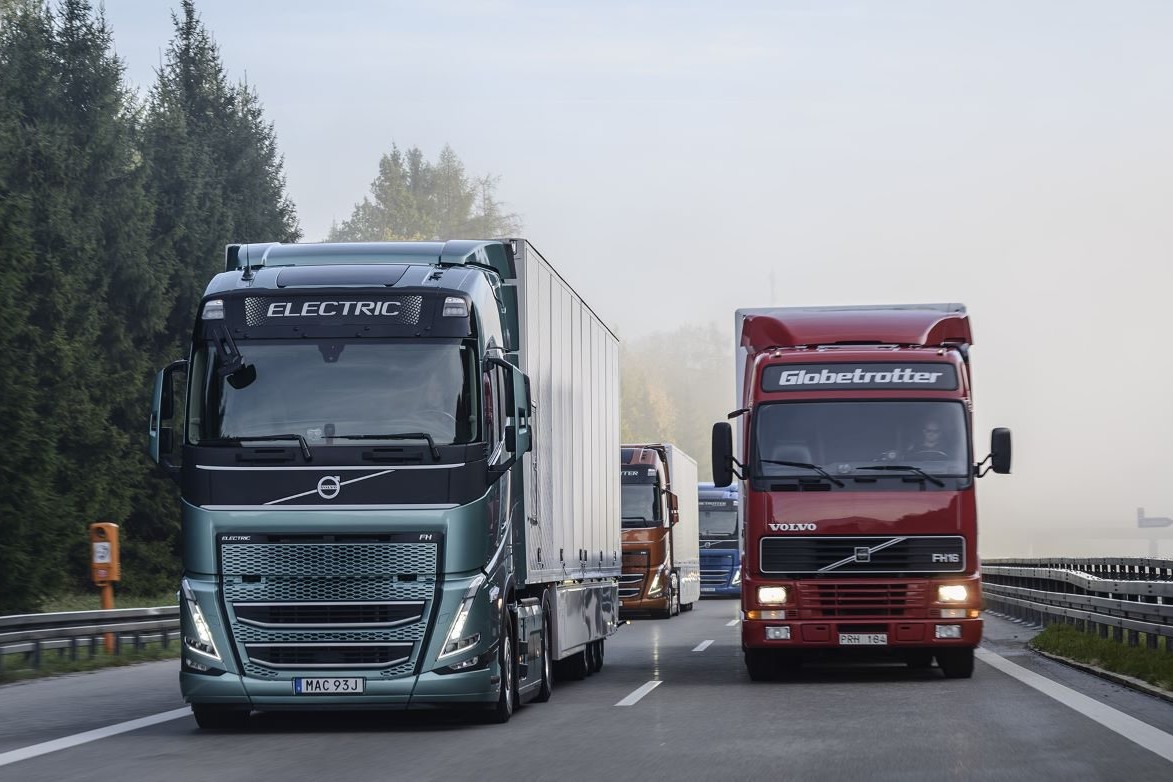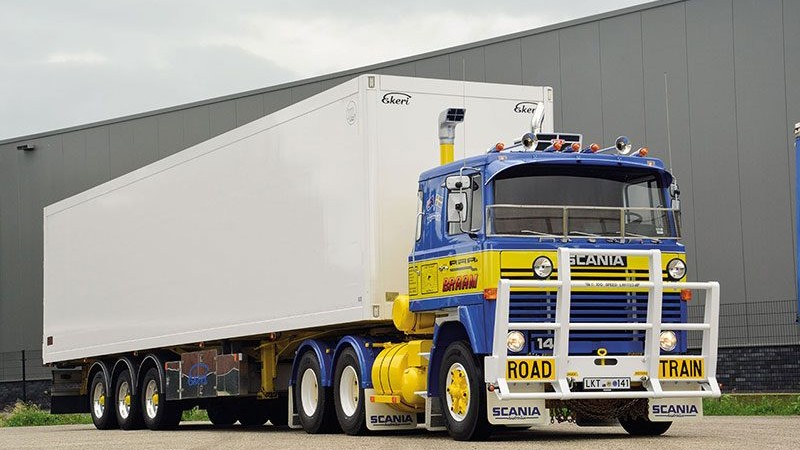
Niels Jansen meets a Dutch truck enthusiast who has imported and restored an Aussie- spec Scania LKT.
Half a century ago, several European heavy-truck manufacturers tried their luck in Australia but failed due to the country’s demanding transport conditions. Scania didn’t want to take a chance, so it developed a custom-built model for the Aussie market where B-doubles and roadtrains are popular, coming up with the introduction slogan, Super Swede. In 1970, sales began Down Under on a small scale. Not long after, the European models were adapted to typical local needs, such as a 6×4 tandem drive with inter-axle lock and cross-locks. Because of the Australian maximum axle load of six tons on the front axle, the cabover models received a forward-mounted steering axle. The Australian version was derived from a previously produced Brazilian type. Most of the LK and LKTs had a big 14L V8 diesel engine. Other characteristic features were the high-raised air filter behind the cab and the upright exhaust stack. Of course, a roo bar and stone catcher to protect the windshield were also part of the package.
More than 20 years ago, Gerard Braam from Wijchen in The Netherlands took on the adventure of bringing such a unique Scania LKT model to Europe. The 60-year-old transport entrepreneur grew up with the Swedish brand as a child and later drove Scania trucks himself in his transport company. Gerard’s father owned a Krupp in 1963 and later a Henschel and Mercedes-Benz. But when work expanded, Scania became the preferred brand. The fleet included a Scania LB80 and a LB110 Super. The latter was also used for demanding haulage tasks to the Middle East. With that, the Scania virus had gained a foothold in the Braam family.
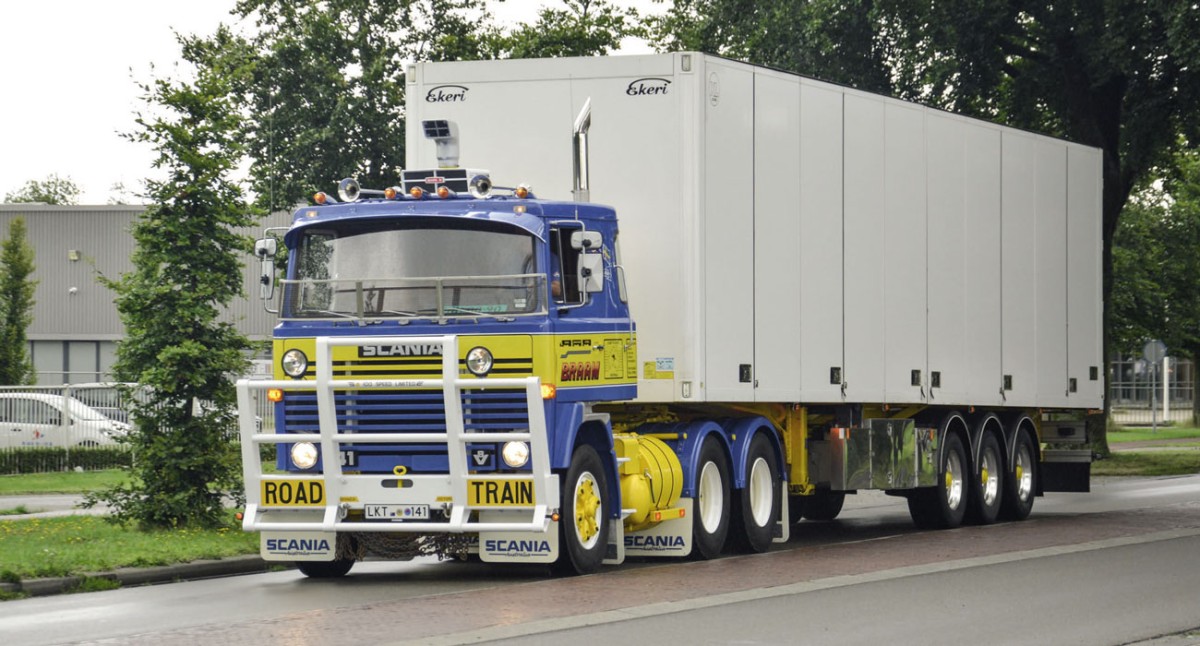
In 1989, Gerard and his youngest brother Bas started their own transport company. He explains: “My father, whose name is also Gerard, continued on his own until 2000 when he turned 65. In 1997, Bas and I split up and I started my own company Eurobraam. We had 10 units then, all Scanias.”
Recently Gerard stopped his transport activities to invest time and money in other areas of interest. In recent years he also sat behind the wheel of a Scania for about 20 hours a week. In the meantime, he had also taken over a Scania-Vabis LB76 Super breakdown truck from his father as a hobby. And the Australian LKT project had also been running for a while by then. So he didn’t have to sit still in ‘retirement’.
The story of this Scania tractor begins in May 2003 when Gerard saw an LKT141 tractor for sale in the magazine Truck Hub while on vacation in Australia.
He recounts: “That sale fell through, unfortunately. Back home, I continued my search on the Internet. In December 2003, I discovered another 1977 LKT that belonged to Peter Hyett in Echuca, Victoria. I bought this truck by phone and immediately hopped on a plane with Wim Nillesen of Scania importer Beers in Holland.”
The LKT owner was a Melbourne farmer who used it to transport wheat in harvest time over 25 years. The tandem axle tractor had about 1,000,000km on the clock. Yet, it still looked good in its plain white colours. That, however, turned out to be wrong later on…
“After settling the payment, I drove it to the port of Melbourne myself. In April 2004, it arrived by ro-ro ship in Europe,” says Gerard.
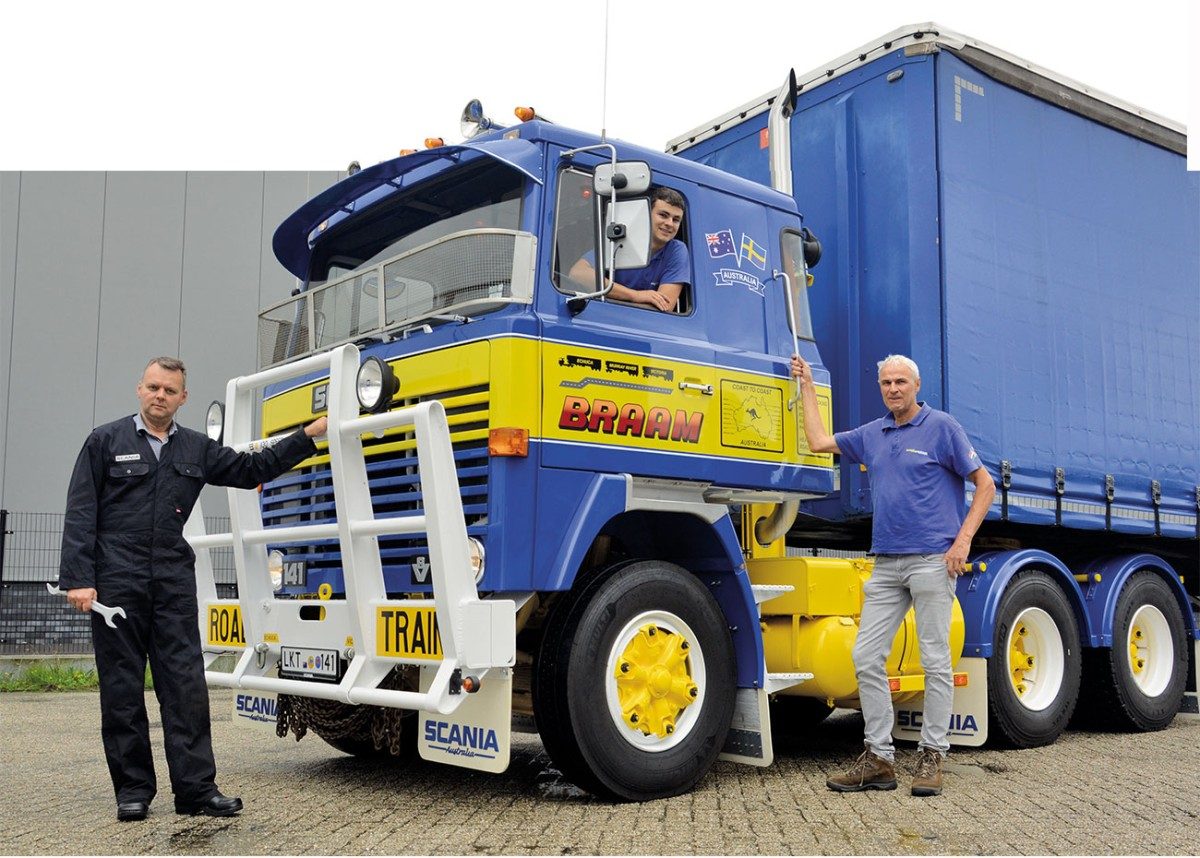
Unfortunately for the new owner, attempts to register it initially failed. Despite various attempts in 2005 by the Dutch Scania importer Beers and the German TüV road authorities, the tractor could not be registered.
“As a result, the project came to a standstill until 10 years later, we resumed the restoration. We completely dismantled the LKT. The chassis was blasted, galvanised and painted yellow and blue.”
In 2017, Gerard contacted truck restorer Theo Klaassen from Echteld because, after closer inspection, the sleeper cab was in worse condition than expected. Theo completely rebuilt the original LKT cab using parts of an ex-Swedish Army Scania LB111. Altogether, the donor was good for about half of the panels that made up the new sleeper cab. The other half was custom-built by Theo.
Because Gerard used to drive an LB111 Scania with a deluxe interior, he also wanted this in the LKT141. The beige and brown trim on the walls, headliner, engine tunnel and dashboard were also custom-made by Theo, as well as the curtains. A professional shop made the seat cushions and bed.
After the cab was painted in the blue and yellow company colours, Gerard opted to do the remaining restoration work himself, assisted by a mechanic. Due to lack of time, however, he decided in 2021 to approach Theo again to complete the restoration. Theo was willing to accept this if he could also do all the finishing work on the Scania.
He explains: “I have a lot of experience restoring LB Scanias. But this job was much more complicated because quite a few parts of the LKT are differently mounted. The model was specially designed for export markets that use a so-called bridge formula for axle loads. The further apart the axles are, the more you are allowed to carry. At the time, the LKs and LKTs were assembled with parts from various other Scania models. Some parts even came from a bonneted model.”
The plan was to rebuild the LKT141 as they were sold in Australia in the 1970s. “Well, pretty much, because we also decided at an early stage to convert the steering from right to left,” says Gerard. “The reason was safety, especially concerning the visibility all around. For me, this also fitted more into my childhood memories.”
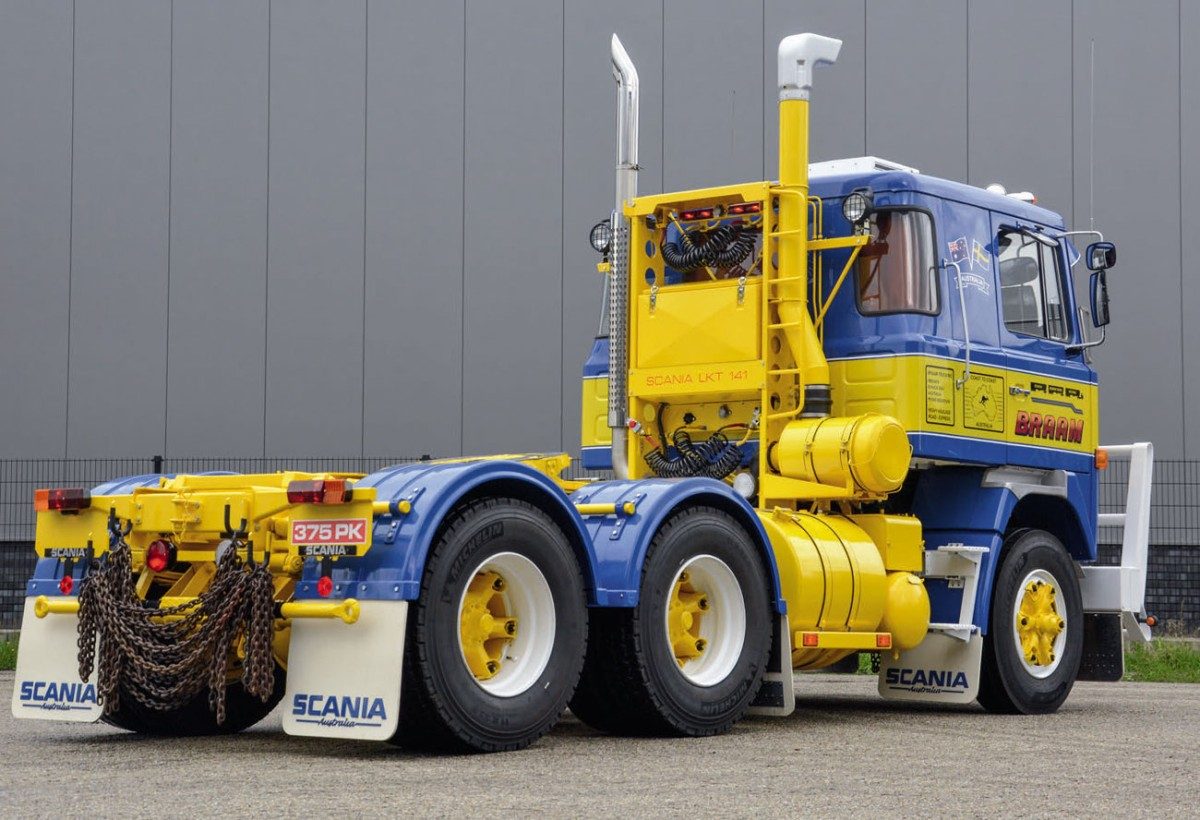
Trilex wheels, snowchains and original (refurbished) roo bar give the truck a tough look.
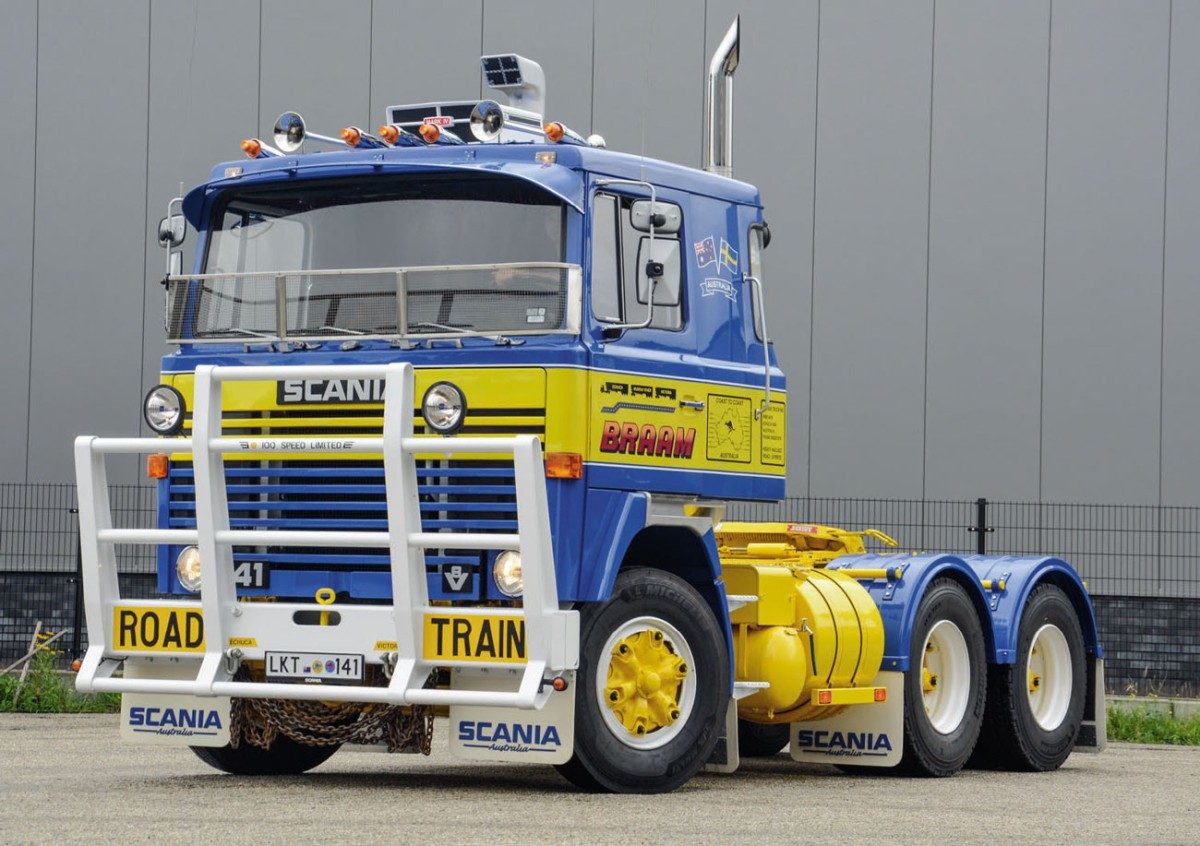
Theo adds: “We also looked at the Brazilian LKs for this conversion, because they were left-hand drive. Also, the brake system had to change. With the LKT, it is all done with forks and rods. That is quite a complicated system and, hence, difficult to convert. The fact that the steering shaft is almost half a metre forward does not help either.”
Regarding the driveline, Gerard had replaced the pistons, cylinder bushings, piston rings and the like by a mechanic at his transport company. The injectors and fuel pump were overhauled by Theo, who also renewed all the pipes and replaced the alternator, clutch plates and release assembly.
A modern Jost sliding fifth wheel was mounted because the Australia-fitted heavy-duty fifth wheel was not allowed in Europe. Behind the cab came a nice rack for air hoses and electricity cables, plus a large locker for various gear. The air intake on the right was mounted high above the cab, as is common in Australia, and the stainless-steel exhaust pipe was custom-made by Theo’s son Nico.
Gerard’s son, Sven, was also involved in the project. “He was responsible for the blue-and-yellow colour scheme,” says Gerard. “The design of the lettering and logos was a joint affair.”
Theo says: “The intention of the whole project was to make the LKT correct in every detail. That is, built within the timeframe of the 1970s in Australia.”
Gerard, who is very pleased with the result, concludes: “Theo is not only a professional when it comes to mechanics and bodywork but also has original ideas when it comes to dressing up a truck.”
After 20 years of ups and downs, a classic truck now stands on Gerard’s driveway that is technically and visually one of a kind in Europe.
Read more
The Foden way
0 Comments7 Minutes
Red-tape resilience
0 Comments12 Minutes
Middle Eastern Magic
0 Comments1 Minute
30 years of innovation
0 Comments13 Minutes










